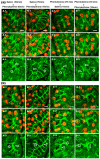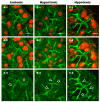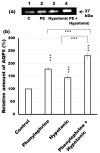Mechanisms Underlying Activation of α₁-Adrenergic Receptor-Induced Trafficking of AQP5 in Rat Parotid Acinar Cells under Isotonic or Hypotonic Conditions
- PMID: 27367668
- PMCID: PMC4964398
- DOI: 10.3390/ijms17071022
Mechanisms Underlying Activation of α₁-Adrenergic Receptor-Induced Trafficking of AQP5 in Rat Parotid Acinar Cells under Isotonic or Hypotonic Conditions
Abstract
Defective cellular trafficking of aquaporin-5 (AQP5) to the apical plasma membrane (APM) in salivary glands is associated with the loss of salivary fluid secretion. To examine mechanisms of α₁-adrenoceptor (AR)-induced trafficking of AQP5, immunoconfocal microscopy and Western blot analysis were used to analyze AQP5 localization in parotid tissues stimulated with phenylephrine under different osmolality. Phenylephrine-induced trafficking of AQP5 to the APM and lateral plasma membrane (LPM) was mediated via the α1A-AR subtype, but not the α1B- and α1D-AR subtypes. Phenylephrine-induced trafficking of AQP5 was inhibited by ODQ and KT5823, inhibitors of nitric oxide (NO)-stimulated guanylcyclase (GC) and protein kinase (PK) G, respectively, indicating the involvement of the NO/ soluble (c) GC/PKG signaling pathway. Under isotonic conditions, phenylephrine-induced trafficking was inhibited by La(3+), implying the participation of store-operated Ca(2+) channel. Under hypotonic conditions, phenylephrine-induced trafficking of AQP5 to the APM was higher than that under isotonic conditions. Under non-stimulated conditions, hypotonicity-induced trafficking of AQP5 to the APM was inhibited by ruthenium red and La(3+), suggesting the involvement of extracellular Ca(2+) entry. Thus, α1A-AR activation induced the trafficking of AQP5 to the APM and LPM via the Ca(2+)/ cyclic guanosine monophosphate (cGMP)/PKG signaling pathway, which is associated with store-operated Ca(2+) entry.
Keywords: aquaporin-5; calcium; hypotonicity; protein G kinase; α1A-adrenoceptor; α1B-adrenoceptor; α1D-adrenoceptor.
Figures









Similar articles
-
Activation of muscarinic receptors in rat parotid acinar cells induces AQP5 trafficking to nuclei and apical plasma membrane.Biochim Biophys Acta. 2015 Apr;1850(4):784-93. doi: 10.1016/j.bbagen.2015.01.009. Epub 2015 Jan 17. Biochim Biophys Acta. 2015. PMID: 25603543
-
The muscarinic acetylcholine receptor-stimulated increase in aquaporin-5 levels in the apical plasma membrane in rat parotid acinar cells is coupled with activation of nitric oxide/cGMP signal transduction.Mol Pharmacol. 2002 Jun;61(6):1423-34. doi: 10.1124/mol.61.6.1423. Mol Pharmacol. 2002. PMID: 12021404
-
alpha(1)-adrenoceptor-induced trafficking of aquaporin-5 to the apical plasma membrane of rat parotid cells.Biochem Biophys Res Commun. 1999 Nov;265(1):94-100. doi: 10.1006/bbrc.1999.1630. Biochem Biophys Res Commun. 1999. PMID: 10548496
-
Aquaporin-5 water channel in lipid rafts of rat parotid glands.Biochim Biophys Acta. 2006 Aug;1758(8):1053-60. doi: 10.1016/j.bbamem.2006.03.026. Epub 2006 Apr 19. Biochim Biophys Acta. 2006. PMID: 16712780 Review.
-
Physiological role of aquaporin 5 in salivary glands.Pflugers Arch. 2016 Apr;468(4):519-39. doi: 10.1007/s00424-015-1749-6. Epub 2015 Nov 5. Pflugers Arch. 2016. PMID: 26537593 Review.
Cited by
-
Effects of oral stimulation with capsaicin on salivary secretion and neural activities in the autonomic system and the brain.J Dent Sci. 2018 Jun;13(2):116-123. doi: 10.1016/j.jds.2017.08.007. Epub 2017 Nov 11. J Dent Sci. 2018. PMID: 30895106 Free PMC article.
-
Salivary gland function, development, and regeneration.Physiol Rev. 2022 Jul 1;102(3):1495-1552. doi: 10.1152/physrev.00015.2021. Epub 2022 Mar 28. Physiol Rev. 2022. PMID: 35343828 Free PMC article. Review.
-
Aquaporin-5 Dynamic Regulation.Int J Mol Sci. 2023 Jan 18;24(3):1889. doi: 10.3390/ijms24031889. Int J Mol Sci. 2023. PMID: 36768212 Free PMC article. Review.
-
Molecular mechanisms governing aquaporin relocalisation.Biochim Biophys Acta Biomembr. 2022 Apr 1;1864(4):183853. doi: 10.1016/j.bbamem.2021.183853. Epub 2021 Dec 30. Biochim Biophys Acta Biomembr. 2022. PMID: 34973181 Free PMC article. Review.
-
Altered expression of aquaporin 1 and aquaporin 5 in the cornea after primary blast exposure.Mol Vis. 2019 Jun 5;25:283-294. eCollection 2019. Mol Vis. 2019. PMID: 31263351 Free PMC article.
References
-
- Raina S., Preston G.M., Guggino W.B., Agre P. Molecular cloning and characterization of an aquaporin cDNA from salivary, lacrimal, and respiratory tissues. J. Biol. Chem. 1995;270:1908–1912. - PubMed
MeSH terms
Substances
LinkOut - more resources
Full Text Sources
Other Literature Sources
Molecular Biology Databases
Research Materials
Miscellaneous

